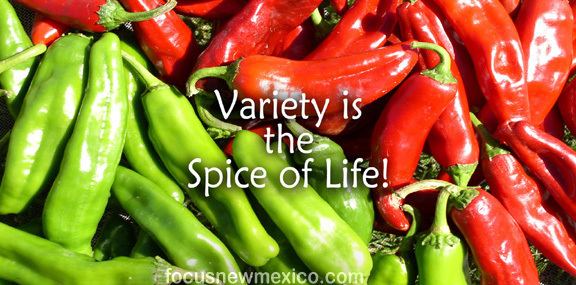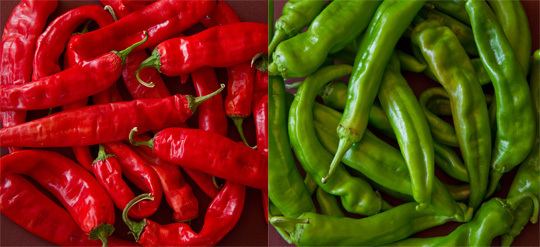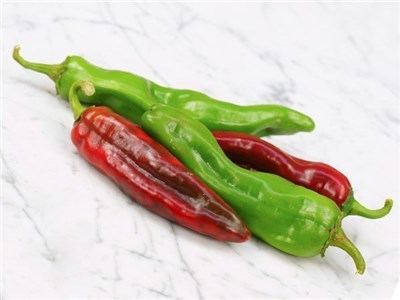Breeder Fabian Garcia Heat Hot | ||
 | ||
Marketing names Hatch chile, green chile, red chile, Anaheim pepper Similar Poblano, Serrano pepper, Guajillo chili, Chile de árbol, Habanero | ||
El pinto hatch new mexico chile fields
New Mexico chile (or New Mexican chile) is a group of cultivars of the chile pepper, initially developed by pioneer horticulturist, Dr. Fabián Garcia, at New Mexico State University in 1894, then known as Las Cruces College and the New Mexico College of Agriculture and Mechanic Arts. Selective breeding began with 14 lineages of 'Pasilla', 'Colorado', and 'Negro' cultivars, from across New Mexico and Southern Colorado's old Hispano and Pueblo communities. These peppers were selected to have a "larger smoother, fleshier, more tapering and shoulderless pod for canning purposes." The first cultivar of this group was released in 1913, called 'New Mexico No. 9'. The New Mexico chile peppers are popular in the cuisine of the Southwestern United States and in the broader Mexican cuisine, and an integral staple of New Mexican cuisine.
Contents
- El pinto hatch new mexico chile fields
- History
- Cultivation
- Hatch chile
- Pueblo chiles
- Rio Grande chile
- Anaheim pepper
- Food
- Roasting
- Art
- Sub cultivars
- References

Chile grown in the Hatch Valley, in and around Hatch, New Mexico, is called Hatch chile, but no one type of chile is specific to that area, which is smaller than the acreage used to produce chiles with the "Hatch" label. The peppers grown in the valley, and along the entire Rio Grande, from northern Taos Pueblo to southern Isleta Pueblo, are a signature crop to New Mexico's economy and culture. The chile pepper is New Mexico's state vegetable, and the official New Mexico state question is "Red or Green?".

The New Mexico green chile pepper flavor has been described as lightly pungent similar to an onion, or like garlic with a subtly sweet, spicy, crisp, and smoky taste. The ripened red retains the flavor, but adds an earthiness and bite while aging mellows the front-heat and delivers more of a back-heat. The spiciness depends on the variety of New Mexico chile peppers.

History

Many types of peppers were first grown by Pueblo residents, who continue to grow their own peppers each with a distinct pungency, sweetness, taste, and heat. For example, the Zia Pueblo pepper has a bitter-sweet flavor when it matures into its red color. When the Spanish arrived, they introduced European cultivation techniques to the chile pepper, and eventually created cultivars in their towns.
The New Mexican type cultivars were developed by pioneer horticulturist, Dr. Fabián Garcia, whose major release was the 'New Mexico No. 9' in 1913. These cultivars are "hotter" than others to suit the tastes of New Mexicans in their traditional foods. Internationally renowned expert on chile genetics, breeding, and germplasm evaluation, Dr. Paul Bosland, founded the Chile Pepper Institute at New Mexico State University to study New Mexico's iconic state vegetable and peppers from around the world.
Cultivation
New Mexico chile peppers are grown from seeds – and each of the individual pepper types is specifically bred and grown to be disease-resistant and provide consistent and healthy plants within their specific regions. Altitude, climate, soil, and acreage affects a crop's taste and heartiness, making the New Mexican region unique for plant propagation. The Rio Grande bosque, mountains, and high deserts provide the appropriate regional environment for growing chiles. To ensure that a variety's lineage remains disease-resistant and maintains optimal growth within its heritage region, seeds from specific plants are carefully selected. An example of a New Mexican chile grown outside the state is the Anaheim peppers which are extremely resilient in multiple altitudes. A quirky aspect of the New Mexico chile pepper regards reintroducing seeds from their heritage soil since each successive generation becomes susceptible to disease and it loses its flavor. Therefore, chile pepper farmers usually order seeds from their heritage soils, every few generations, to reinvigorate their crop. This allows the New Mexico chile pepper growers to perpetuate successful productions. Seed distributors and sellers from New Mexico, California, and Colorado provide this service to farmers.
New Mexico chile peppers grown in New Mexico are the most sought after, since their flavor, texture, and hardiness are heavily dependent on their growing environment. The peppers were originally grown by the Pueblo, and each of their distinct Pueblo peppers grows best in its heritage soil. This same trend has continued with other New Mexico chile peppers, those grown by the farmers among the Spanish, Mexican, and American frontiersmen. Among the New Mexico-grown chile peppers, the ones with the most accolades are grown along the Rio Grande, especially along the Hatch Valley.
A certification program was started in 2014, New Mexico Certified Chile, attempting to certify the growing of New Mexico chile peppers. The program tries to protect New Mexico chile consumers from falsely labeled products, while protecting farmers from a potential diminishing of demand, and to allow larger amounts of New Mexico chile to be grown within the state. Since the program is rather new, it has garnered some criticism, especially in regard to restricting smaller farmers who have been growing peppers from lineages of more than 400 years of seeds.
Hatch chile
Hatch chile refers to varieties of species of the genus Capsicum which are grown in the Hatch Valley, an area stretching north and south along the Rio Grande from Arrey, New Mexico, in the north to Tonuco Mountain to the southeast of Hatch, New Mexico. The soil and growing conditions in the Hatch Valley create a unique terroir which contributes to the flavor of chile grown there. Most of the varieties of chile cultivated in the Hatch Valley have been developed at New Mexico State University over the last 130 years.
Hatch chile can be purchased locally in many parts of the Southwest, and is distributed throughout the United States by companies such as World Variety Produce. Other distributors sometimes use the "Hatch" name, but do not actually grow and process their chile in the Hatch Valley. To protect Hatch and other New Mexican growers, state legislators passed a 2012 law protecting and prohibiting the "New Mexican" identity brand for state grown peppers. This law does not extend to chiles grown outside the state. Chiles grown around the town are marketed under the name of the town, and are often sold fresh-roasted in New Mexico and neighboring states in the early autumn.
Pueblo chiles
Pueblo chiles have been cultivated by the Puebloan peoples of New Mexico for centuries. The Acoma Pueblo chile pepper is mild, with a lightly flavorful pungency. The Isleta Pueblo chile pepper becomes a fruity sweet flavor as it grows into its red chile state. The Zia Pueblo chile pepper becomes a bitter-sweet flavor when it matures into its red color, and its heat is similar to the 'Heritage 6-4'.
These ancient Pueblo varieties should not be confused with chile peppers grown in Pueblo, Colorado, a variety of the guajillo chili, otherwise known as the mirasol pepper. They are distinct in and of themselves, but are not related to New Mexico chile.
Rio Grande chile
Along the rest of the Rio Grande, outside of the Hatch Valley, multiple other locations grow award-winning chiles in their own right.
Towns and cities across New Mexico have strong chile traditions, including; Chimayo, Española, Corrales, and from Bosque Farms to Los Ranchos de Albuquerque in the Albuquerque area.
Anaheim pepper
An Anaheim pepper is a mild variety of the New Mexico chile pepper cultivar No. 9. The name "Anaheim" derives from Emilio Ortega, a farmer who brought the seeds from New Mexico to the Anaheim, California, area in 1894. They are also called California chile or Magdalena, and dried as chile seco del norte.
The chile "heat" of Anaheims varies from 500 to 2,500 on the Scoville scale; however, typical cultivars grown in New Mexico can selectively and uniformly range from 500 to 10,000 Scoville units.
Food
The most commonly grown New Mexico chile peppers are the 'New Mexico 6-4', 'Big Jim', 'Sandia', and 'No. 6' and 'No. 9' cultivars. The improved 'Heritage 6-4', 'Heritage Big Jim', and 'Sandia Select' cultivars provide a better yield and uniformity. Anaheim peppers are commonly grown outside of New Mexico, and are related to the 'New Mexico No. 6 and 9', but when grown out of state, they have a higher variability rate.
Green chiles are served roasted and peeled, whole or diced, and in various sauces. The most common uses for these diced chiles, or sauces, is in enchiladas, burritos, burgers, french fries, or rice. They are also served whole raw or as fried or baked chile rellenos. New Mexican-style chile rellenos follow the much more traditional Mexican technique of being covered with egg batter and fried, although variations and casseroles do exist.
In addition to local restaurants, many national food chains such as McDonald's and Jack in the Box offer locally grown green chile on many of their menu items in New Mexico.
The red chile, the matured green chile, is frequently dried and ground to a powder. These dried or powdered peppers are turned into a red chile sauce. The dried peppers are rehydrated by boiling in a pot, and then blended with various herbs and spices, such as onion and garlic. The red chile powder is usually simply blended with water, herbs, and spices.
Serving both red and green chile sauces on a dish is sometimes referred to as "Christmas" style. Both green and red chile can be dried and turned into a powder, though this is more common with red chile.
Roasting
Chile roasting refers to roasting of green chiles, most commonly occurring during harvest season, in autumn, throughout New Mexico. The process can be done at the time of purchase, in an oven (horno), or at home.
The commercial process, done at purchase, usually involves an operator taking the part as chile roaster which involves standing near and turning a cylindrical cage drum over propane fueled flames, ensuring the chile pods are heated on every side, as they shed their skins; this ensures the chile skins blister appropriately, to allow for easier peeling of the chile. This process is the most popular method, since the smell has become a staple during the early New Mexican autumn, it offers a physical display of the chile, it offers the sound of the chiles crackling, the sight of the blistering and falling skins, accompanied by the widely distributed smell of the roasting peppers.
Horno-roasting the chiles, while done less often, is a traditional method of roasting the chile. A more common method is simply roasting over an open flame on gas stove-tops and grills.
Art
A ristra is an arrangement of drying chili pepper pods, and is a popular decorative design in the state of New Mexico, some households use ristras as a means to dry and procure red chile.
The red and green chile peppers are often depicted in New Mexican artwork as symbols of New Mexican cuisine.
Sub-cultivars
Though most New Mexico type peppers are long pod-type peppers, that ripen from green to red, the multitude of New Mexico type cultivars have a slight variance in taste, and widely varying appearances and heat levels. Some varieties may turn yellow, orange, or brown.
The most common New Mexico chile peppers are the New Mexico 6-4, Big Jim, Sandia, and No. 6 and 9 cultivars. Peppers like the Chimayo, Velarde, Jemez, Escondida, Alcalde, San Filipe, Española, and several others, represent what is known as the New Mexico's unique landrace chiles, which provide their own unique tastes and usually command a higher price.
